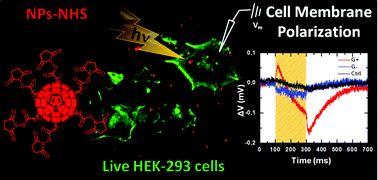Engineering thiophene-based nanoparticles to induce phototransduction in live cells under illumination†
Abstract
We report that nanoparticles prepared from appropriately functionalized polythiophenes once administered to live cells can acquire phototransduction properties under illumination, becoming photoactive sites able to absorb visible light and convert it to an electrical signal through cell membrane polarization. Amine-reactive fluorescent nanoparticles with pendant N-succinimidyl-ester groups (NPs-NHS) are prepared from polythiophenes alternating unsubstituted and 3-(2,5-dioxopyrrolidin-1-yl-8-octanoate)-substituted thiophenes by a nanoprecipitation method. By 1H NMR of nanoparticles prepared using THF-d8/D2O (solvent/non-solvent) we demonstrate that the hydrolysis of the N-succinimidyl-ester group to free N-hydroxysuccinimide takes place slowly over several hours. NPs-NHS reactivity towards primary amine groups is tested towards the NH2 of D- and L-enantiomers of tryptophan. We show that the formation of a tryptophan-nanoparticle amidic bond creates a chiral shell displaying opposite CD signals for the nanoparticles bound to D or L enantiomers. The interaction of NPs-NHS with live HEK-293 cells is monitored via LSCM. We show that the NPs-NHS are not internalized but remain docked on the cell membrane. We assume that this is mainly the result of the reaction of the NHS groups in the external layer with NH2 groups present in cell membrane proteins, although the contribution of alternative mechanisms cannot be excluded. To support this assumption LSCM experiments show that nanoparticles of comparable size obtained from poly(3-hexylthiophene), NPs-P3HT, are rapidly internalized by live HEK-293 cells. Finally, using the whole-cell current clamp technique under light illumination we demonstrate that NPs-NHS can polarize the cell membrane upon light irradiation while NPs-P3HT cannot.



 Please wait while we load your content...
Please wait while we load your content...